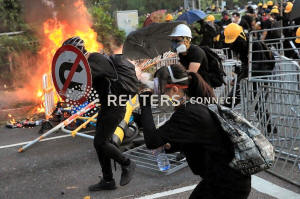Streets of Hong Kong become protest battlefield on China National Day
 Send a link to a friend
Send a link to a friend
 [October 01, 2019]
By Jessie Pang and Donny Kwok [October 01, 2019]
By Jessie Pang and Donny Kwok
HONG KONG (Reuters) - Hong Kong police
fired tear gas and rubber bullets at pro-democracy protesters throwing
petrol bombs in the Asian financial hub on Tuesday as its Chinese rulers
celebrated the 70th anniversary of the founding of the People's
Republic.
Cat-and-mouse clashes spread from the upmarket district of Causeway Bay
to the Admiralty area of government offices on Hong Kong island.
Violence also escalated across the harbor to Kowloon and beyond to the
New Territories in the most widespread unrest in nearly four months.
The South China Morning Post and television reports said at least one
person was wounded in the chest by police firing live rounds. Police did
not respond to requests for comment but have said they fired live rounds
into the air in previous clashes.
Video footage of a police officer firing at a protester at close range
went viral, but there was not immediate verification of its
authenticity.
Fifteen people were wounded across the territory, one critically, the
Hospital Authority said without giving details.

Police fired water cannon and volley after volley of tear gas to
disperse protesters throwing Molotov cocktails outside central
government offices in the Admiralty area and ordered the evacuation of
the Legislative Council building next door.
Police said "rioters" had used corrosive fluid in Tuen Mun in the west
of the New Territories, "injuring multiple police officers and
reporters". No details were immediately available.
The territory has been tense for weeks, with protests often turning
violent, as authorities tried to avoid activists spoiling Beijing's
birthday parade at a time when the central government is already
grappling with a U.S.-China trade war and a slowing economy.
By the afternoon, police and protesters were involved in standoffs
across Hong Kong, with the streets littered with tear gas canisters and
other debris.
Nearly four months of street clashes and demonstrations have plunged the
former British colony into its biggest political crisis in decades and
pose the most serious popular challenge to President Xi Jinping since he
came to power.
Earlier, thousands of black-clad protesters, some wearing Guy Fawkes
masks, marched from Causeway Bay toward government headquarters in
Admiralty, defying a ban on a rally.
Rail operator MTR Corp shut down many of its metro stations to stop
protesters moving around. Shutting stations have made them a common
target for attack, and a fire was lit at Admiralty station on Tuesday.
Protesters had vowed to seize the opportunity on China's National Day to
propel their calls for greater democracy onto the international stage,
hijacking an occasion Beijing sees as an opportunity to showcase China's
economic and military progress.
"Iím not young, but if we donít march now, weíll never have the chance
to speak again, itís as simple as that,Ē said one marcher near Causeway
Bay, a 42-year-old woman with her own logistics company who identified
herself as Li.
[to top of second column]
|

An anti-government protester shelters with a traffic sign during a
demonstration in Sha Tin district, on China's National Day in Hong
Kong, China October 1, 2019. REUTERS/Jorge Silva

Hundreds of officials and members of Hong Kong's pro-establishment
elite began the day with a flag-raising ceremony and National Day
reception at the Convention and Exhibition Centre, held early and
moved behind closed doors. Roads to the center were closed and
tightly policed.
Hong Kong had benefited from China's support under the "one country,
two systems" policy, Acting Chief Executive Matthew Cheung told the
assembly, referring to guarantees of political freedoms after the
city's handover from British to Chinese rule in 1997.
But he said escalating violence was disrupting social order and
hurting the economy.
The government of embattled leader Carrie Lam has already canceled
an annual Oct. 1 fireworks display over the city's Victoria Harbour,
citing public safety.
Lam, who was trapped in a stadium for hours last week after
attending the "open dialogue", left for Beijing on Monday to
celebrate China's birthday on the mainland. She will return on
Tuesday.
CHOREOGRAPHED FESTIVITIES
In contrast to events in Hong Kong, Beijing's carefully
choreographed anniversary festivities included troops marching
through part of Tiananmen Square with new missiles and floats
celebrating the country's technological prowess.
Lam was shown on television smiling as a float celebrating Hong Kong
went past as she sat with Chinese officials.
The Communist Party leadership is determined to project an image of
national strength and unity in the face of challenges including Hong
Kong's unrest.
"On our journey forward, we must uphold the principles of peaceful
reunification and one country, two systems; maintain lasting
prosperity and stability in Hong Kong and Macau ... and continue to
strive for the motherland's complete reunification," Xi said in a
nationally televised speech in Beijing.
Hong Kong protesters are angry about what they see as creeping
Chinese interference in the Asian financial center.
China dismisses the accusation and has accused foreign governments,
including the United States and Britain, of fanning anti-China
sentiment.

(Reporting by Jessie Pang and Donny Kwok, Additional reporting by
Sharon Tam, Poppy McPherson, Anne Marie Roantree, Farah Master,
James Pomfret, Twinnie Siu, Alun John, David Kirton, Jennifer Hughes
and Keith Zhai; Writing by Clara Ferreira Marques, Bill Rigby and
Nick Macfie; Editing by Lincoln Feast, Robert Birsel and Raju
Gopalakrishnan)
[© 2019 Thomson Reuters. All rights
reserved.]
Copyright 2019 Reuters. All rights reserved. This material may not be published,
broadcast, rewritten or redistributed.
Thompson Reuters is solely responsible for this content. |